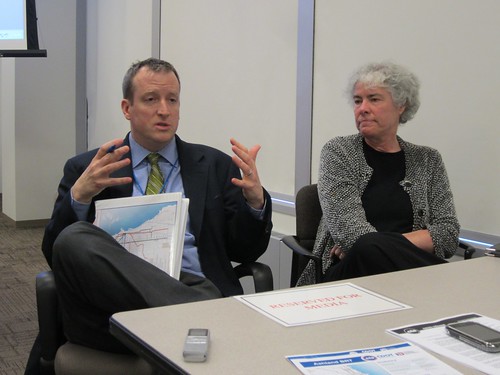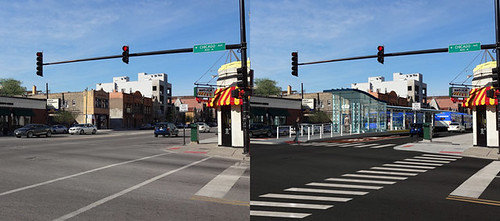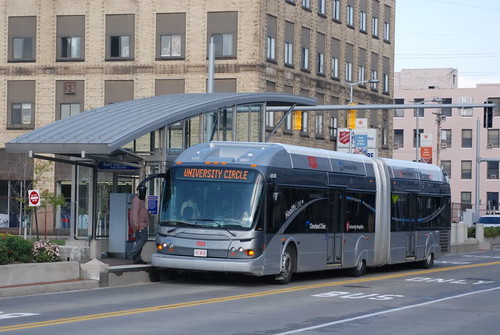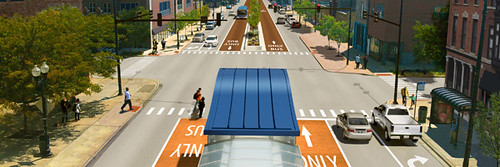It was exciting to wake up to the news that the CTA and Chicago Department of Transportation are planning to build center-running bus rapid transit with travel lane removals, since this is the most efficient and pedestrian-friendly of the four layouts they considered. Both Ashland and Western were possibilities for the route. They have decided to go with 16 miles of Ashland from Irving Park to 95th, starting with an initial segment running from the Orange Line at 31st to Metra’s Clybourn station at Cortland. You can read the basics of the proposal in Ben Fried’s earlier post about the announcement.
Soon after I received the good word, the CTA invited me to their downtown headquarters for a Q & A session with Kevin O’Malley, the agency’s general manager of strategic planning and policy, and CDOT Deputy Commissioner Luann Hamilton. They provided the following additional details about the plan.
Why Ashland instead of Western? Ashland is the highest traveled bus corridor in the city, connecting seven CTA ‘L’ stations and two Metra stations. Ashland also includes several different business and retail corridors, plus the Illinois Medical District. Its curb-to-curb right-of-way, 70 feet, is slightly wider overall than Western. “And the Ashland bus currently operates about one mile-per-hour slower, so we thought we could really move the needle to a faster and more reliable service for more people,” O’Malley said.
Cost The first 5.5-mile phase between 31st and Cortland is estimated at $116 million, including purchasing new buses with left-side doors, required for center-running BRT. In general the corridor will cost $10 million per mile for the street improvements and stations alone, so the entire 16-mile route will come to $160 million, not including buses.
Funding The city plans to apply for grants from the Federal Transportation Administration’s Small Starts program, which provides funding for capital costs associated with new rail systems and line extensions, as well as bus corridor improvements.
Schedule Depending on the availability of federal funding, construction on the first phase between 31st and Cortland could start as early as 2015 with service launching by the end of the year or in early 2016.
Vehicles While Ashland currently has standard 40-foot buses, the CTA is planning to buy articulated buses with a total of five doors on both sides, which are currently in use on Cleveland’s Health Line express bus corridor.
Features Ashland would be the first U.S. bus route to achieve the Institute for Transportation and Development Policy’s gold-standard rating. In addition to center-running buses and dedicated bus lanes, there will be sinal prioritization and pre-paid, level boarding. “Having people line up at [an onboard] fare box would defeat the point of faster service,” O’Malley said. The bus-only lanes will be colored and possibly camera-enforced. While Jersey walls won’t be used to keep cars out of the lanes, there may be other treatments like bollards or rumble strips.
Local buses While the BRT buses will only stop every half-mile, local buses will continue to run curbside, so they won’t slow down the express vehicles. Local service will likely become less frequent. “Service is always set by demand,” O’Malley said. “We anticipate that BRT will attract up to 29 percent more ridership to this corridor. But the local buses will remain as needed.”
Service to Andersonville? While community leaders in Andersonville had expressed interest in extending the Ashland BRT corridor north to their neighborhood and beyond, the line will stop at Irving Park, the northern terminus of the #9 bus. O'Malley said the CTA decided not to extend the BRT north of Irving Park on Ashland because it's a residential section that doesn't currently have bus service. “And when you get north of Irving, Clark Street [which has a bus line] starts to get very close [to Ashland] … so it would start to get kind of redundant.”
Cortland Stop This area, below the Kennedy and Metra tracks, is currently a dark, dirty space that may intimidate some riders. “We’ll be working within the context we have there,” O’Malley said. “It is a challenging one, but our goal is to make it an inviting place for people to make a transfer [to BRT] from the Metra or the east-west buses.”
Likely location of the Cortland stop, in the median of Ashland, south of the intersection.
I also spoke with CTA spokesman Brian Steele about how the agency plans to convince residents and business owners that the BRT project, which will remove travel lanes and most left turns but retain almost all parking spaces, is a good idea.
John Greenfield: It seems that whatever configuration you choose, whether it was removing parking on one side of the street, or removing travel lanes, some people are going to be unhappy about it. I attended a meeting where business owners were really upset about the idea of losing parking or losing left turns.
Brian Steele: You were at some of the public input meetings and have heard some the concerns, and CTA and CDOT really listened to all that feedback and particularly those concerns. And that’s part of why center-running BRT was chosen. Center-running preserves 92 percent of the off-street parking and 96 percent of the loading zones. That was one of the biggest concerns that we heard at the public meeting, because business owners see that as being critical to helping their business. Of course, we believe that transit is just as, if not more, critical to their businesses. If you look at the most vibrant commercial and retail corridors in the city, almost without exception they have the common element of good transit access.
JG: It’s definitely going to be tough for most Chicagoans to wrap their heads around the idea that taking out travel lanes is going to expedite transportation in general. It seems like a lot of people are going to panic when they hear the city is going to take out lanes. What’s the strategy to win them over to the plan?
BS: That was one of the issues that we heard about when we had the open houses last fall, the concern about what’s going to happen if you reduce capacity on Ashland, which is an arterial street intended to carry higher traffic volumes. The response to that is what you’ve seen at the meetings we’ve already had, and a lot of the details are going to come about in the analysis that we’re going to do moving forward. Based on some very preliminary traffic modeling that we’ve done using traffic data from [the Chicago Metropolitan Agency for Planning], it’s suggested that vehicle travel speeds would only be impacted by one-to-two miles per hour.
We want to emphasize that the preliminary information shows that the impact will not be so significant that it has an overly detrimental impact on traffic flow and traffic volumes on Ashland. And in other cities, like New York’s Select bus service [which converted travel lanes into dedicated bus lanes], there were the same concerns voiced and it turns out that overall travel times were not greatly impacted.
Now that we’ve announced this vision there are going to be a lot of questions and concerns. That’s why we’re having this huge community outreach component. We’ve been meeting with community groups and elected officials, having open house, etcetera, for a year-and-a-half or so. Those are going to be continued and expanded as part of our education and outreach and feedback campaign.








